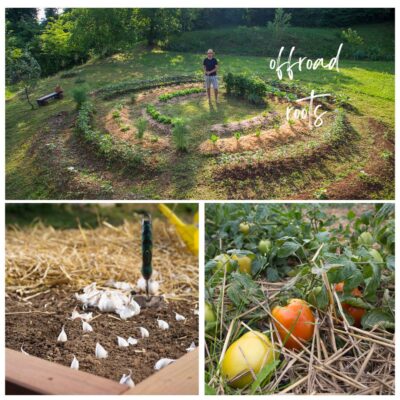
Permaculture – The Cycle of Life
Initially, I thought that the “forest garden” and the principle of permaculture were for those who love untamed growth and the “lazy” who still want to garden – but now my view and attitude towards it have drastically changed. How exciting and diverse this principle of cultivation and gardening turns out to be and how much knowledge and potential lie hidden within, waiting to be discovered, is truly fascinating. This is definitely not for the “lazy minds.”
Of course, one must appreciate the wild growth and natural appearance, otherwise, it might seem a bit too colorful and too natural for some. As I reorient myself step by step and would like everything to be “finished” by tomorrow, I am reminded again that everything happens in a cycle and therefore needs its time.
The Cycle of Life – The Seasons
Thus, the cycle of life can be well illustrated by the example of a year. The phases of growth, maturity, decay, and renewal that are inherent in all living beings.
Spring – The Time of Awakening and Growth
Just as spring symbolizes rebirth and new beginnings, it represents birth and youth in the life cycle. In spring, the world wakes up from the quiet of winter. Seeds germinate, flowers bloom, and young animals are born. It is a time of rapid growth and development, where everything is alive, fresh, and full of energy.
Summer – The Time of Maturity and Harvest
Summer corresponds to adulthood in the life cycle. It is the time when life reaches its peak, vibrant and strong. The trees are in full foliage, the animals are active, and the days are long and warm. This season represents the period of greatest activity and engagement with the world, reflecting the productive and established phase in an individual’s life.
Autumn – Retreat, Reflection, and Preparation for a New Beginning
With the arrival of autumn, the onset of decline begins. The leaves change color and fall, and many plants die back or set seeds for the next generation. In the life cycle, this phase corresponds to middle age to advanced age and reflects a time of reflection, letting go, and preparation for the end of active growth.
Winter – The Time of Rest and Renewal
Winter signifies a time of rest, where the landscape lies dormant under a blanket of snow. Many animals hibernate or reduce their activities. This is comparable to the later stages of life, old age, and ultimately death. Yet, just as winter is not the final end in the annual cycle, it suggests that death is not the end of the life cycle. Beneath the snow, seeds are preparing to sprout in the next cycle, symbolizing hope and the potential for new life.
Each season is necessary, and each has its beauty and purpose. They all contribute to the ongoing cycle that sustains ecosystems and ensures the continuity of life. The cycle of the year also reminds us of the transience of existence and the relevance of each phase in the larger pattern of life.
Sustainability and Regeneration
In permaculture, the cycle especially stands for sustainability and regeneration. It’s about creating systems that sustain and renew themselves, where waste products are reused as resources, and biodiversity and natural resilience are promoted. The cycle represents the principles of permaculture, which are based on the observation of natural ecosystems and cycles to design healthy and productive environments.
The circular economy is a fundamental element of permaculture and refers to the creation of closed systems where resources are used efficiently and waste is minimized or even eliminated. In permaculture, this approach is realized by imitating patterns and relationships that occur in nature.
Key aspects include:
- Sustainable resource use: Permaculture systems aim to use resources such as water, energy, food, and materials in closed loops. For example, rainwater is harvested and used for irrigation, waste heat from composting processes heats greenhouses, or plant residues are used as mulch or compost.
- Soil fertility: Building and maintaining fertile soils is central. Organic waste is composted and used as natural fertilizer to improve soil structure and fertility, making the use of chemical fertilizers redundant.
- Food security: By diversifying plants and animals within the system, a resilient and productive food base is created that adapts to local conditions while promoting biodiversity.
- Energy efficiency: Permaculture systems strive to source energy from sustainable sources and create energy cycles, where, for example, the waste heat of one process is used in another.
- Integrated animal husbandry: Animals play a central role in permaculture systems, as they not only provide food but can also convert waste products into valuable resources (for example, chicken manure is used as fertilizer) and for us, it’s the horse manure.
- Economic cycles: Permaculture promotes local economic cycles by supporting local production and consumption, thus reducing transport routes and associated environmental impacts.
- Community and sharing: Permaculture principles also include social aspects by promoting community gardens, seed exchange, and collectively used resources.
- Waste reduction: Materials that are no longer needed are either integrated into other processes or processed so that they can be safely returned to the environment.
By applying these principles, permaculture aims to create sustainable, self-supporting, and more resilient systems that are beneficial to both the human community and the environment in the long term.
All the aspects mentioned for me come together into such a coherent, nature-connected and nature-binding whole that symbolizes an attitude and way of life. It is more a state of being than doing – or in permaculture, the knowledge exists that every action, every doing, has an effect.
In permaculture, the systemic attitude is visible.
